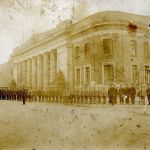

The neoclassical coliseum was designed by Shopbell & Company and provided the community with its first modern facility for conventions and other public gatherings. The ceremonial aspect of the building was heightened by placing the structure directly on an axis with Fourth Street. Rockport native George H. Honig created two heroic monuments that flank the entrance. The Spirit of 1865, on the left, represents victory for the Union. The Spirit of 1916, on the right, shows the reflective elderly veterans of the Civil War.
Once considered the premier location for events in Evansville, the Coliseum was seen as dated and small when Roberts Municipal Stadium was built in the mid 1950s. When a push for “urban renewal” involving demolitions occurred in the city, the Coliseum was threatened. A “Save the Coliseum” campaign was developed and the same organization that helped save the Old Vanderburgh County Courthouse stepped in.
In 1919 a 4,000 pipe concert organ was installed as a memorial to Prof. Z. M. Tinker, for years supervisor of music in the local public schools. At the time of its installation it was among the largest municipal pipe organs in the world. As of 2013, the University of Evansville is attempting to purchase the pipe organ, dismantle it, restore it to full operating condition, and re-install it in the Neu Chapel on campus.
When the Old National Events Plaza was later constructed, the Colisum’s use as an auditorium and convention space waned. In 1971 Vanderburgh County leased the building to the Vanderburgh County Veterans Council for a period of 99 years at the rate of $1 a year.
The Coliseum’s Convention Hall still retains a seating capacity of 2,400 and a standing room capacity of 4,055. The Veterans Council leases out the venue for sporting events, exhibitions, stage plays, wedding receptions, musical productions, bingo, concerts, and philanthropic organizations.
Artifact Inventory
Brother David Hoesli did an inventory of G.A.R. items in the Coliseum and provided this inventory below.
Located in a locked cabinet in the G.A.R. Room
GAR Records Book “A” 6-1881 to 12-1889
GAR Records Book “C” 1-1900 to 12-1908
GAR Record Book 1-1921 to 11-1927
GAR Cash Book 1-1-1909 to 5-10-1923
GAR Cash Book 7-1910 to 9-18-1919
GAR Cash Book 5-1923 to 6-1935
GAR Deaths 1888 to 1897
GAR Deaths 12-4-1927 to 3-1934
GAR Membership Records
GAR Register of Warrants
Misc. Scrap books & photographs
Stuck in a refrigerator in a room just off the GAR Room
WRC Journals (7) dating from 8-5-1943 to 6-6-1968
WRC Membership Books (5) dating from 1-3-1927 to 5-17-1954
WRC Ritual Book (Membership) 9-3-1937 to 8-5-1940
WRC Black Book (Members Dropped)
WRC Roll of Members 8-1885 to 1896
DUV Historian Book 1-17-1927 to 12-5-1960
DUV Minute Books (11) dating from 10-26-1926 to 5-19-1975
DUV Dues Book 1-1942 to 1-15-1976
DUV Cash Book 1-1948 to 6-1954
DUV Cash Book 7-2-1964 to 7-2-1965
DUV Roll of Members 11-1928 to 7-1943
DUV Roll of Members 1952 to 1968
DUV Membership Book 5-6-1919 to 12-17-1934
In another room just off the GAR Room
Trunk with GAR Encampment tent and reunion artifacts.
Same trunk has several Civil War artifacts belonging to GAR veterans including cartridge boxes, cap boxes, belts, etc.
Second Floor
All original GAR chairs and misc. items once used in the room during GAR meetings.


